University of Suffolk: Business Law and Ethics Report on Negligence
VerifiedAdded on 2023/01/11
|7
|1841
|86
Report
AI Summary
This report provides a detailed analysis of a business law and ethics case concerning the tort of negligence. The report begins with an introduction explaining the importance of equality and the role of law in business. The main body of the report presents an overview of the case involving Extortionate PLC and Samantha, who suffered an injury due to negligence. It then discusses the applicable rules, specifically the Tort of Negligence, and its four essential elements: duty, breach, causation, and damages. The report also examines the application of the law of tort to the case, concluding that Extortionate PLC was negligent. The conclusion emphasizes the significance of both law and ethics in business and highlights the consequences of violating ethical or legal standards. The report refers to various books and journals on the topic.

Business Law and Ethics
Secure Best Marks with AI Grader
Need help grading? Try our AI Grader for instant feedback on your assignments.
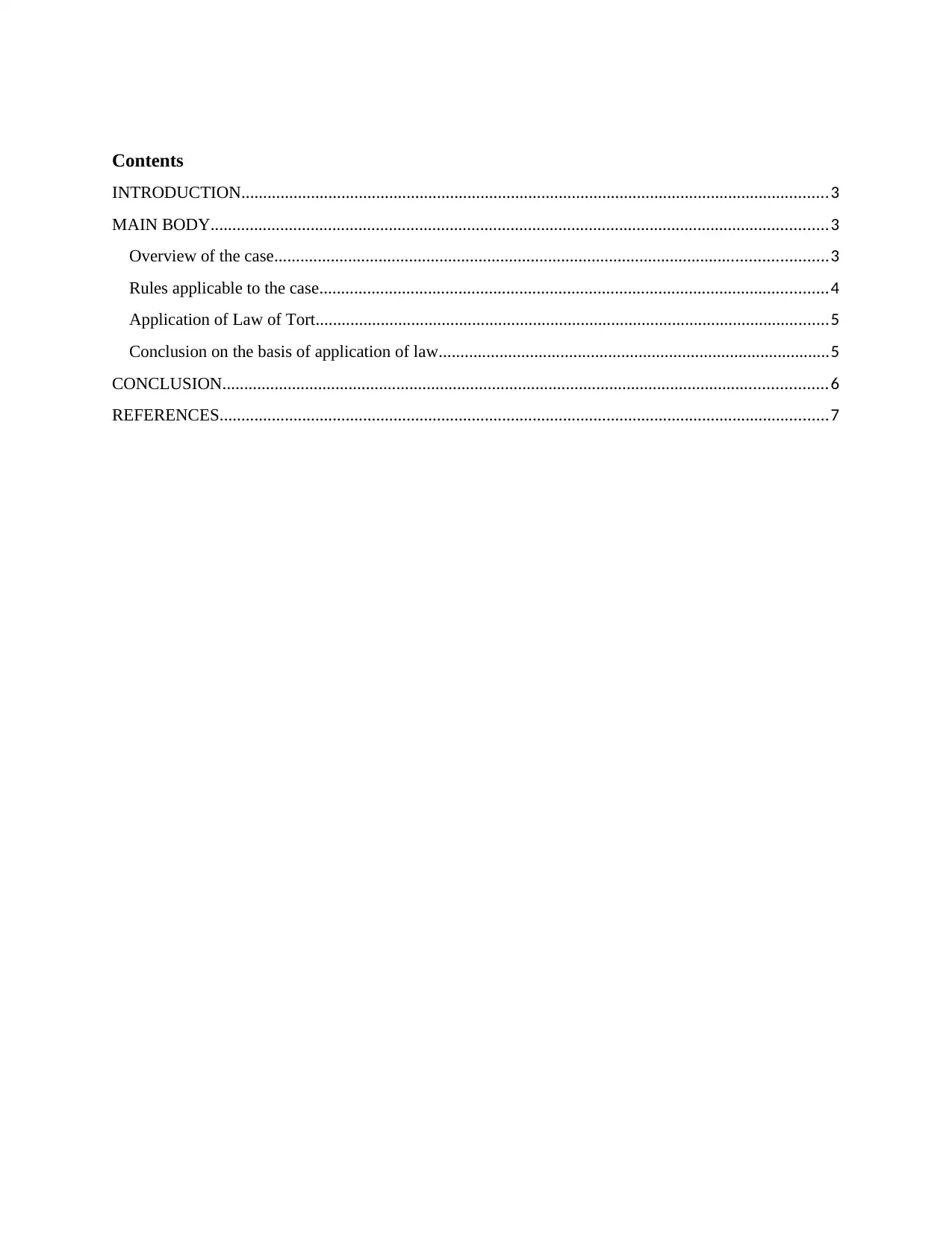
Contents
INTRODUCTION.......................................................................................................................................3
MAIN BODY..............................................................................................................................................3
Overview of the case...............................................................................................................................3
Rules applicable to the case.....................................................................................................................4
Application of Law of Tort......................................................................................................................5
Conclusion on the basis of application of law..........................................................................................5
CONCLUSION...........................................................................................................................................6
REFERENCES............................................................................................................................................7
INTRODUCTION.......................................................................................................................................3
MAIN BODY..............................................................................................................................................3
Overview of the case...............................................................................................................................3
Rules applicable to the case.....................................................................................................................4
Application of Law of Tort......................................................................................................................5
Conclusion on the basis of application of law..........................................................................................5
CONCLUSION...........................................................................................................................................6
REFERENCES............................................................................................................................................7
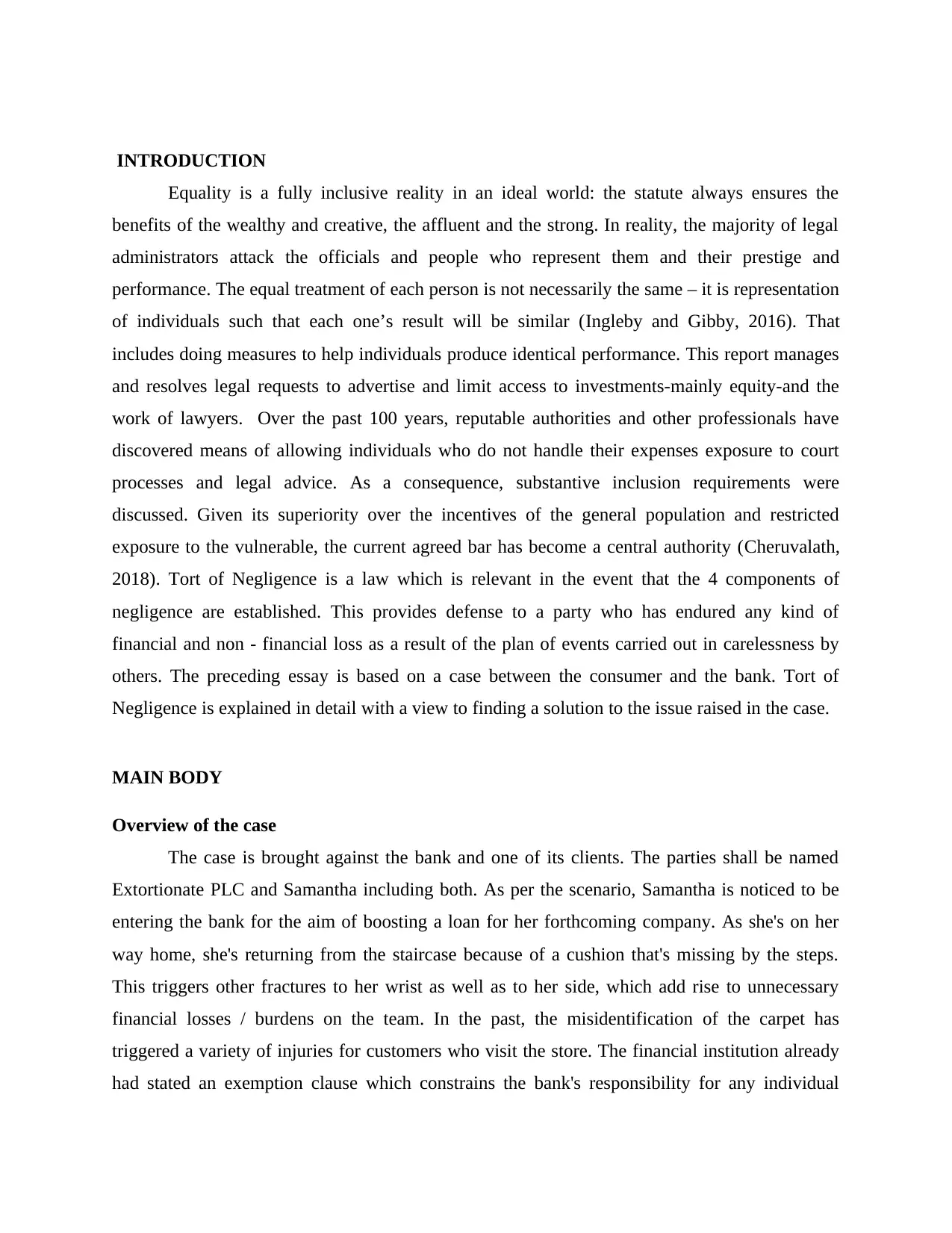
INTRODUCTION
Equality is a fully inclusive reality in an ideal world: the statute always ensures the
benefits of the wealthy and creative, the affluent and the strong. In reality, the majority of legal
administrators attack the officials and people who represent them and their prestige and
performance. The equal treatment of each person is not necessarily the same – it is representation
of individuals such that each one’s result will be similar (Ingleby and Gibby, 2016). That
includes doing measures to help individuals produce identical performance. This report manages
and resolves legal requests to advertise and limit access to investments-mainly equity-and the
work of lawyers. Over the past 100 years, reputable authorities and other professionals have
discovered means of allowing individuals who do not handle their expenses exposure to court
processes and legal advice. As a consequence, substantive inclusion requirements were
discussed. Given its superiority over the incentives of the general population and restricted
exposure to the vulnerable, the current agreed bar has become a central authority (Cheruvalath,
2018). Tort of Negligence is a law which is relevant in the event that the 4 components of
negligence are established. This provides defense to a party who has endured any kind of
financial and non - financial loss as a result of the plan of events carried out in carelessness by
others. The preceding essay is based on a case between the consumer and the bank. Tort of
Negligence is explained in detail with a view to finding a solution to the issue raised in the case.
MAIN BODY
Overview of the case
The case is brought against the bank and one of its clients. The parties shall be named
Extortionate PLC and Samantha including both. As per the scenario, Samantha is noticed to be
entering the bank for the aim of boosting a loan for her forthcoming company. As she's on her
way home, she's returning from the staircase because of a cushion that's missing by the steps.
This triggers other fractures to her wrist as well as to her side, which add rise to unnecessary
financial losses / burdens on the team. In the past, the misidentification of the carpet has
triggered a variety of injuries for customers who visit the store. The financial institution already
had stated an exemption clause which constrains the bank's responsibility for any individual
Equality is a fully inclusive reality in an ideal world: the statute always ensures the
benefits of the wealthy and creative, the affluent and the strong. In reality, the majority of legal
administrators attack the officials and people who represent them and their prestige and
performance. The equal treatment of each person is not necessarily the same – it is representation
of individuals such that each one’s result will be similar (Ingleby and Gibby, 2016). That
includes doing measures to help individuals produce identical performance. This report manages
and resolves legal requests to advertise and limit access to investments-mainly equity-and the
work of lawyers. Over the past 100 years, reputable authorities and other professionals have
discovered means of allowing individuals who do not handle their expenses exposure to court
processes and legal advice. As a consequence, substantive inclusion requirements were
discussed. Given its superiority over the incentives of the general population and restricted
exposure to the vulnerable, the current agreed bar has become a central authority (Cheruvalath,
2018). Tort of Negligence is a law which is relevant in the event that the 4 components of
negligence are established. This provides defense to a party who has endured any kind of
financial and non - financial loss as a result of the plan of events carried out in carelessness by
others. The preceding essay is based on a case between the consumer and the bank. Tort of
Negligence is explained in detail with a view to finding a solution to the issue raised in the case.
MAIN BODY
Overview of the case
The case is brought against the bank and one of its clients. The parties shall be named
Extortionate PLC and Samantha including both. As per the scenario, Samantha is noticed to be
entering the bank for the aim of boosting a loan for her forthcoming company. As she's on her
way home, she's returning from the staircase because of a cushion that's missing by the steps.
This triggers other fractures to her wrist as well as to her side, which add rise to unnecessary
financial losses / burdens on the team. In the past, the misidentification of the carpet has
triggered a variety of injuries for customers who visit the store. The financial institution already
had stated an exemption clause which constrains the bank's responsibility for any individual
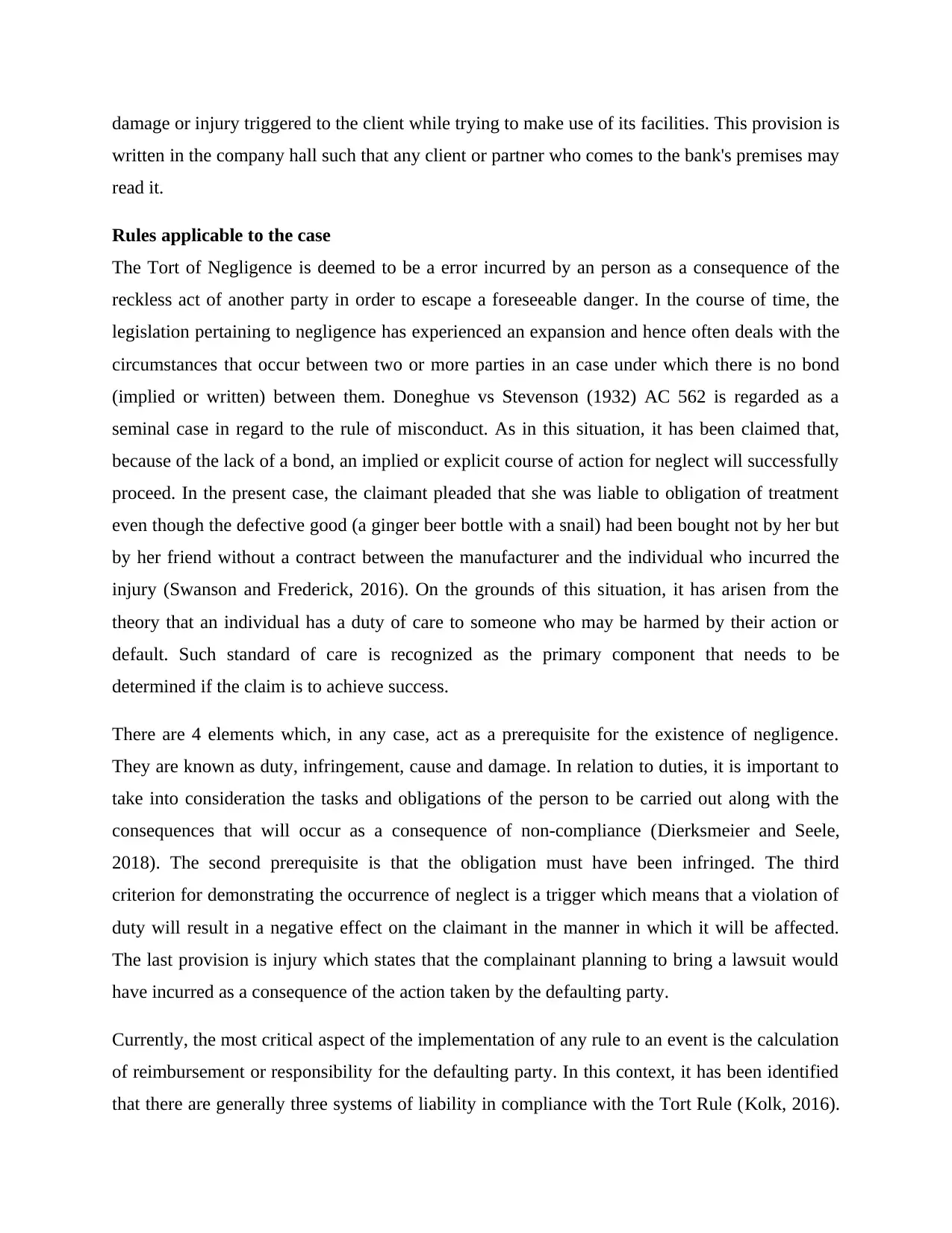
damage or injury triggered to the client while trying to make use of its facilities. This provision is
written in the company hall such that any client or partner who comes to the bank's premises may
read it.
Rules applicable to the case
The Tort of Negligence is deemed to be a error incurred by an person as a consequence of the
reckless act of another party in order to escape a foreseeable danger. In the course of time, the
legislation pertaining to negligence has experienced an expansion and hence often deals with the
circumstances that occur between two or more parties in an case under which there is no bond
(implied or written) between them. Doneghue vs Stevenson (1932) AC 562 is regarded as a
seminal case in regard to the rule of misconduct. As in this situation, it has been claimed that,
because of the lack of a bond, an implied or explicit course of action for neglect will successfully
proceed. In the present case, the claimant pleaded that she was liable to obligation of treatment
even though the defective good (a ginger beer bottle with a snail) had been bought not by her but
by her friend without a contract between the manufacturer and the individual who incurred the
injury (Swanson and Frederick, 2016). On the grounds of this situation, it has arisen from the
theory that an individual has a duty of care to someone who may be harmed by their action or
default. Such standard of care is recognized as the primary component that needs to be
determined if the claim is to achieve success.
There are 4 elements which, in any case, act as a prerequisite for the existence of negligence.
They are known as duty, infringement, cause and damage. In relation to duties, it is important to
take into consideration the tasks and obligations of the person to be carried out along with the
consequences that will occur as a consequence of non-compliance (Dierksmeier and Seele,
2018). The second prerequisite is that the obligation must have been infringed. The third
criterion for demonstrating the occurrence of neglect is a trigger which means that a violation of
duty will result in a negative effect on the claimant in the manner in which it will be affected.
The last provision is injury which states that the complainant planning to bring a lawsuit would
have incurred as a consequence of the action taken by the defaulting party.
Currently, the most critical aspect of the implementation of any rule to an event is the calculation
of reimbursement or responsibility for the defaulting party. In this context, it has been identified
that there are generally three systems of liability in compliance with the Tort Rule (Kolk, 2016).
written in the company hall such that any client or partner who comes to the bank's premises may
read it.
Rules applicable to the case
The Tort of Negligence is deemed to be a error incurred by an person as a consequence of the
reckless act of another party in order to escape a foreseeable danger. In the course of time, the
legislation pertaining to negligence has experienced an expansion and hence often deals with the
circumstances that occur between two or more parties in an case under which there is no bond
(implied or written) between them. Doneghue vs Stevenson (1932) AC 562 is regarded as a
seminal case in regard to the rule of misconduct. As in this situation, it has been claimed that,
because of the lack of a bond, an implied or explicit course of action for neglect will successfully
proceed. In the present case, the claimant pleaded that she was liable to obligation of treatment
even though the defective good (a ginger beer bottle with a snail) had been bought not by her but
by her friend without a contract between the manufacturer and the individual who incurred the
injury (Swanson and Frederick, 2016). On the grounds of this situation, it has arisen from the
theory that an individual has a duty of care to someone who may be harmed by their action or
default. Such standard of care is recognized as the primary component that needs to be
determined if the claim is to achieve success.
There are 4 elements which, in any case, act as a prerequisite for the existence of negligence.
They are known as duty, infringement, cause and damage. In relation to duties, it is important to
take into consideration the tasks and obligations of the person to be carried out along with the
consequences that will occur as a consequence of non-compliance (Dierksmeier and Seele,
2018). The second prerequisite is that the obligation must have been infringed. The third
criterion for demonstrating the occurrence of neglect is a trigger which means that a violation of
duty will result in a negative effect on the claimant in the manner in which it will be affected.
The last provision is injury which states that the complainant planning to bring a lawsuit would
have incurred as a consequence of the action taken by the defaulting party.
Currently, the most critical aspect of the implementation of any rule to an event is the calculation
of reimbursement or responsibility for the defaulting party. In this context, it has been identified
that there are generally three systems of liability in compliance with the Tort Rule (Kolk, 2016).
Secure Best Marks with AI Grader
Need help grading? Try our AI Grader for instant feedback on your assignments.
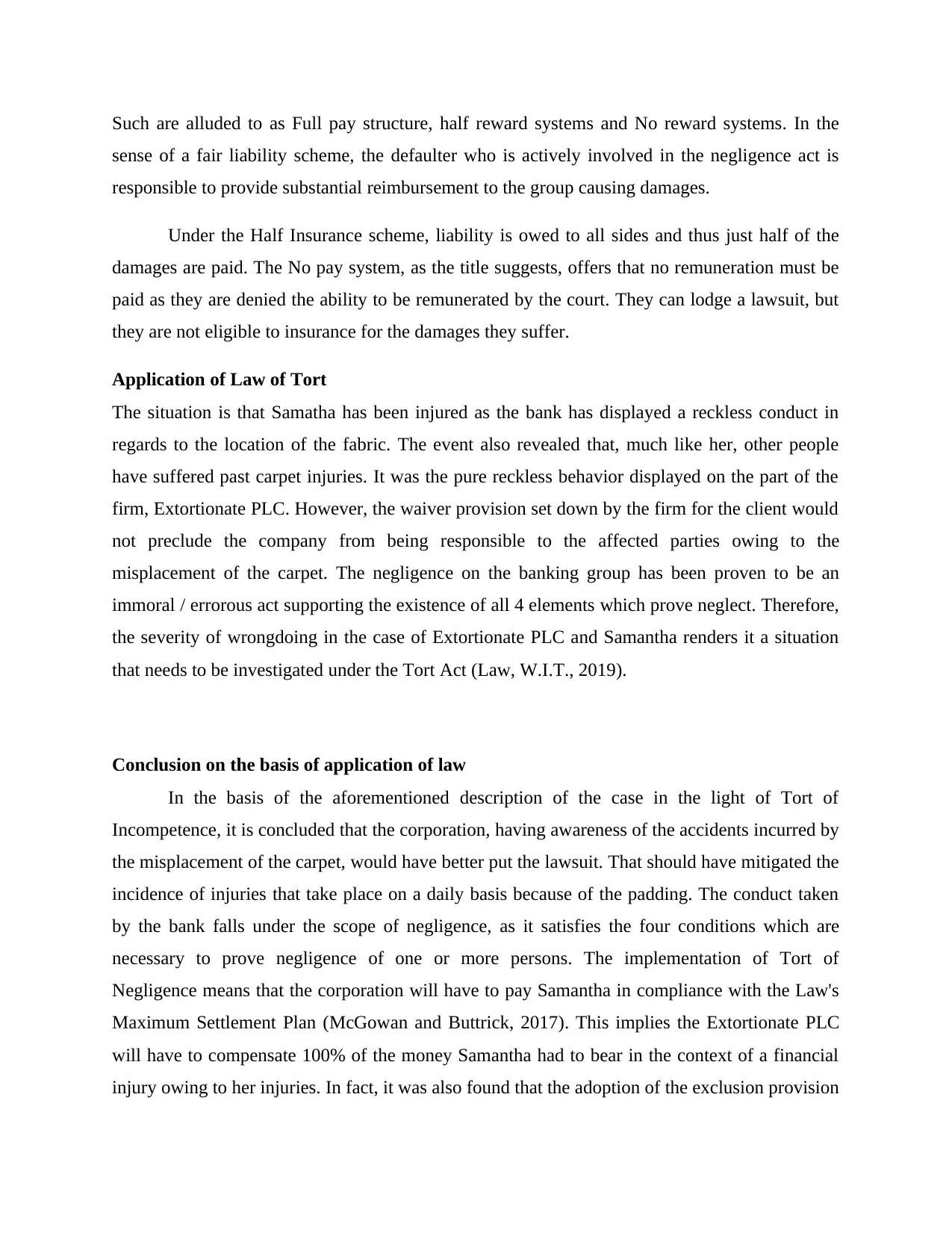
Such are alluded to as Full pay structure, half reward systems and No reward systems. In the
sense of a fair liability scheme, the defaulter who is actively involved in the negligence act is
responsible to provide substantial reimbursement to the group causing damages.
Under the Half Insurance scheme, liability is owed to all sides and thus just half of the
damages are paid. The No pay system, as the title suggests, offers that no remuneration must be
paid as they are denied the ability to be remunerated by the court. They can lodge a lawsuit, but
they are not eligible to insurance for the damages they suffer.
Application of Law of Tort
The situation is that Samatha has been injured as the bank has displayed a reckless conduct in
regards to the location of the fabric. The event also revealed that, much like her, other people
have suffered past carpet injuries. It was the pure reckless behavior displayed on the part of the
firm, Extortionate PLC. However, the waiver provision set down by the firm for the client would
not preclude the company from being responsible to the affected parties owing to the
misplacement of the carpet. The negligence on the banking group has been proven to be an
immoral / errorous act supporting the existence of all 4 elements which prove neglect. Therefore,
the severity of wrongdoing in the case of Extortionate PLC and Samantha renders it a situation
that needs to be investigated under the Tort Act (Law, W.I.T., 2019).
Conclusion on the basis of application of law
In the basis of the aforementioned description of the case in the light of Tort of
Incompetence, it is concluded that the corporation, having awareness of the accidents incurred by
the misplacement of the carpet, would have better put the lawsuit. That should have mitigated the
incidence of injuries that take place on a daily basis because of the padding. The conduct taken
by the bank falls under the scope of negligence, as it satisfies the four conditions which are
necessary to prove negligence of one or more persons. The implementation of Tort of
Negligence means that the corporation will have to pay Samantha in compliance with the Law's
Maximum Settlement Plan (McGowan and Buttrick, 2017). This implies the Extortionate PLC
will have to compensate 100% of the money Samantha had to bear in the context of a financial
injury owing to her injuries. In fact, it was also found that the adoption of the exclusion provision
sense of a fair liability scheme, the defaulter who is actively involved in the negligence act is
responsible to provide substantial reimbursement to the group causing damages.
Under the Half Insurance scheme, liability is owed to all sides and thus just half of the
damages are paid. The No pay system, as the title suggests, offers that no remuneration must be
paid as they are denied the ability to be remunerated by the court. They can lodge a lawsuit, but
they are not eligible to insurance for the damages they suffer.
Application of Law of Tort
The situation is that Samatha has been injured as the bank has displayed a reckless conduct in
regards to the location of the fabric. The event also revealed that, much like her, other people
have suffered past carpet injuries. It was the pure reckless behavior displayed on the part of the
firm, Extortionate PLC. However, the waiver provision set down by the firm for the client would
not preclude the company from being responsible to the affected parties owing to the
misplacement of the carpet. The negligence on the banking group has been proven to be an
immoral / errorous act supporting the existence of all 4 elements which prove neglect. Therefore,
the severity of wrongdoing in the case of Extortionate PLC and Samantha renders it a situation
that needs to be investigated under the Tort Act (Law, W.I.T., 2019).
Conclusion on the basis of application of law
In the basis of the aforementioned description of the case in the light of Tort of
Incompetence, it is concluded that the corporation, having awareness of the accidents incurred by
the misplacement of the carpet, would have better put the lawsuit. That should have mitigated the
incidence of injuries that take place on a daily basis because of the padding. The conduct taken
by the bank falls under the scope of negligence, as it satisfies the four conditions which are
necessary to prove negligence of one or more persons. The implementation of Tort of
Negligence means that the corporation will have to pay Samantha in compliance with the Law's
Maximum Settlement Plan (McGowan and Buttrick, 2017). This implies the Extortionate PLC
will have to compensate 100% of the money Samantha had to bear in the context of a financial
injury owing to her injuries. In fact, it was also found that the adoption of the exclusion provision
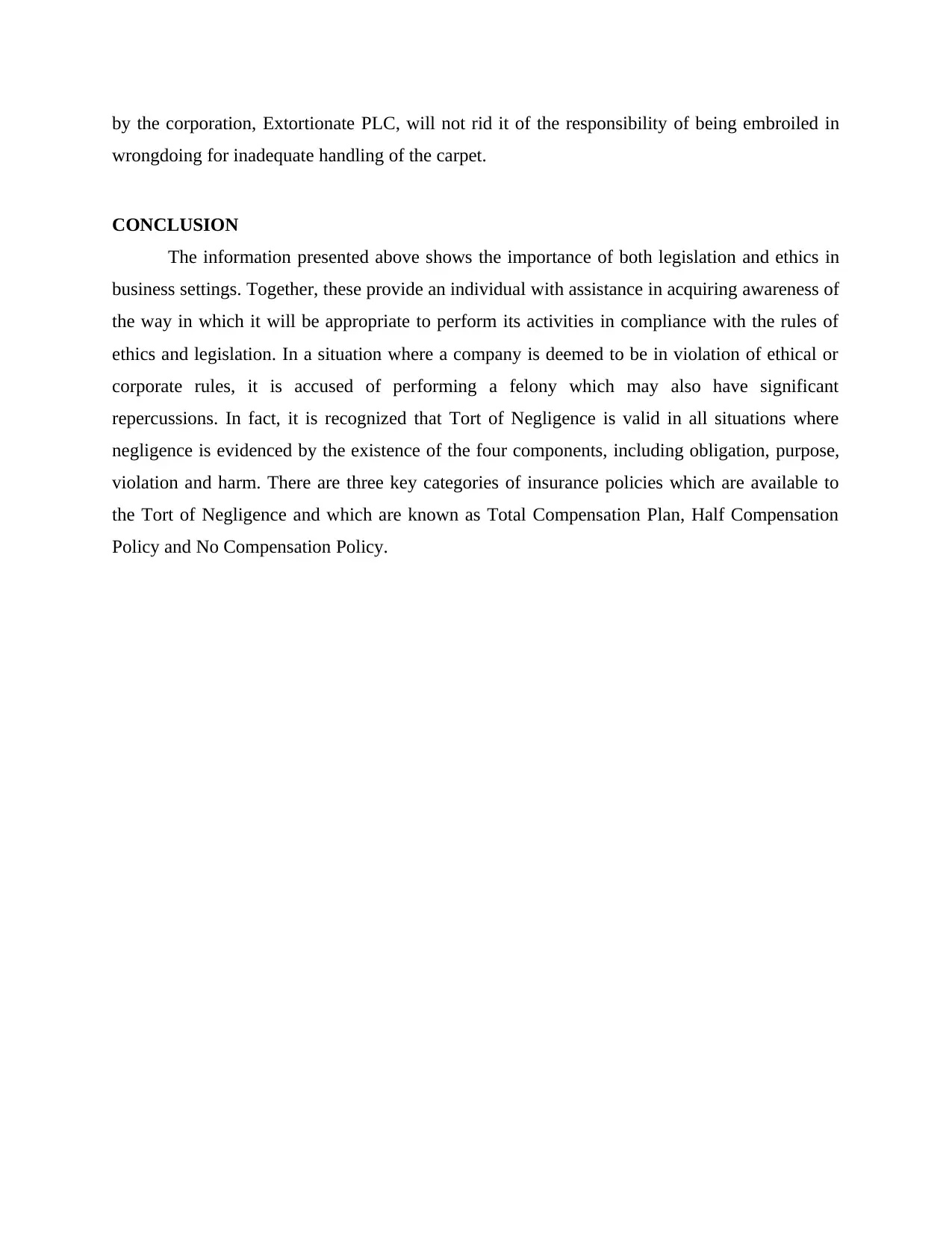
by the corporation, Extortionate PLC, will not rid it of the responsibility of being embroiled in
wrongdoing for inadequate handling of the carpet.
CONCLUSION
The information presented above shows the importance of both legislation and ethics in
business settings. Together, these provide an individual with assistance in acquiring awareness of
the way in which it will be appropriate to perform its activities in compliance with the rules of
ethics and legislation. In a situation where a company is deemed to be in violation of ethical or
corporate rules, it is accused of performing a felony which may also have significant
repercussions. In fact, it is recognized that Tort of Negligence is valid in all situations where
negligence is evidenced by the existence of the four components, including obligation, purpose,
violation and harm. There are three key categories of insurance policies which are available to
the Tort of Negligence and which are known as Total Compensation Plan, Half Compensation
Policy and No Compensation Policy.
wrongdoing for inadequate handling of the carpet.
CONCLUSION
The information presented above shows the importance of both legislation and ethics in
business settings. Together, these provide an individual with assistance in acquiring awareness of
the way in which it will be appropriate to perform its activities in compliance with the rules of
ethics and legislation. In a situation where a company is deemed to be in violation of ethical or
corporate rules, it is accused of performing a felony which may also have significant
repercussions. In fact, it is recognized that Tort of Negligence is valid in all situations where
negligence is evidenced by the existence of the four components, including obligation, purpose,
violation and harm. There are three key categories of insurance policies which are available to
the Tort of Negligence and which are known as Total Compensation Plan, Half Compensation
Policy and No Compensation Policy.
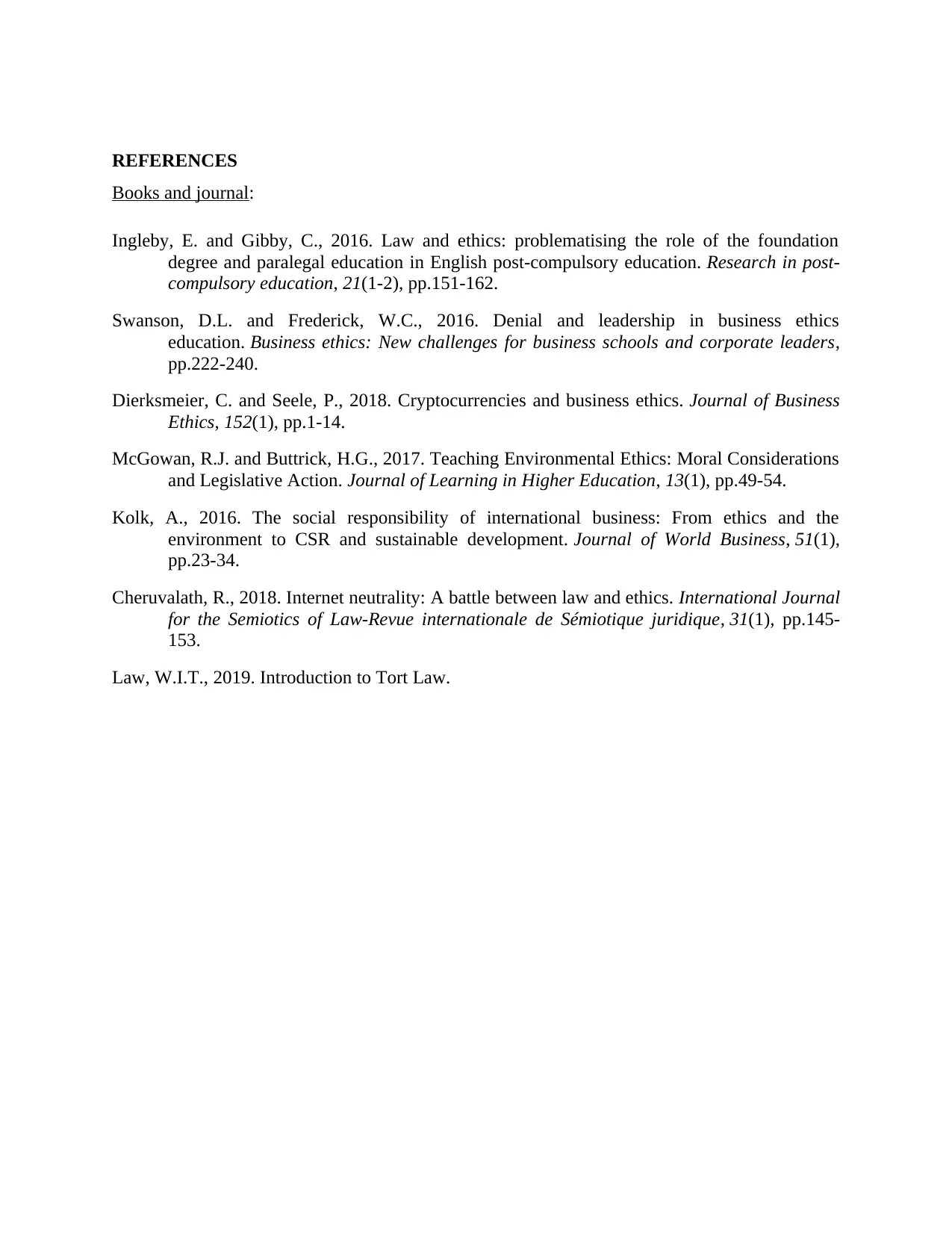
REFERENCES
Books and journal:
Ingleby, E. and Gibby, C., 2016. Law and ethics: problematising the role of the foundation
degree and paralegal education in English post-compulsory education. Research in post-
compulsory education, 21(1-2), pp.151-162.
Swanson, D.L. and Frederick, W.C., 2016. Denial and leadership in business ethics
education. Business ethics: New challenges for business schools and corporate leaders,
pp.222-240.
Dierksmeier, C. and Seele, P., 2018. Cryptocurrencies and business ethics. Journal of Business
Ethics, 152(1), pp.1-14.
McGowan, R.J. and Buttrick, H.G., 2017. Teaching Environmental Ethics: Moral Considerations
and Legislative Action. Journal of Learning in Higher Education, 13(1), pp.49-54.
Kolk, A., 2016. The social responsibility of international business: From ethics and the
environment to CSR and sustainable development. Journal of World Business, 51(1),
pp.23-34.
Cheruvalath, R., 2018. Internet neutrality: A battle between law and ethics. International Journal
for the Semiotics of Law-Revue internationale de Sémiotique juridique, 31(1), pp.145-
153.
Law, W.I.T., 2019. Introduction to Tort Law.
Books and journal:
Ingleby, E. and Gibby, C., 2016. Law and ethics: problematising the role of the foundation
degree and paralegal education in English post-compulsory education. Research in post-
compulsory education, 21(1-2), pp.151-162.
Swanson, D.L. and Frederick, W.C., 2016. Denial and leadership in business ethics
education. Business ethics: New challenges for business schools and corporate leaders,
pp.222-240.
Dierksmeier, C. and Seele, P., 2018. Cryptocurrencies and business ethics. Journal of Business
Ethics, 152(1), pp.1-14.
McGowan, R.J. and Buttrick, H.G., 2017. Teaching Environmental Ethics: Moral Considerations
and Legislative Action. Journal of Learning in Higher Education, 13(1), pp.49-54.
Kolk, A., 2016. The social responsibility of international business: From ethics and the
environment to CSR and sustainable development. Journal of World Business, 51(1),
pp.23-34.
Cheruvalath, R., 2018. Internet neutrality: A battle between law and ethics. International Journal
for the Semiotics of Law-Revue internationale de Sémiotique juridique, 31(1), pp.145-
153.
Law, W.I.T., 2019. Introduction to Tort Law.
1 out of 7
Related Documents
Your All-in-One AI-Powered Toolkit for Academic Success.
+13062052269
info@desklib.com
Available 24*7 on WhatsApp / Email
![[object Object]](/_next/static/media/star-bottom.7253800d.svg)
Unlock your academic potential
© 2024 | Zucol Services PVT LTD | All rights reserved.





